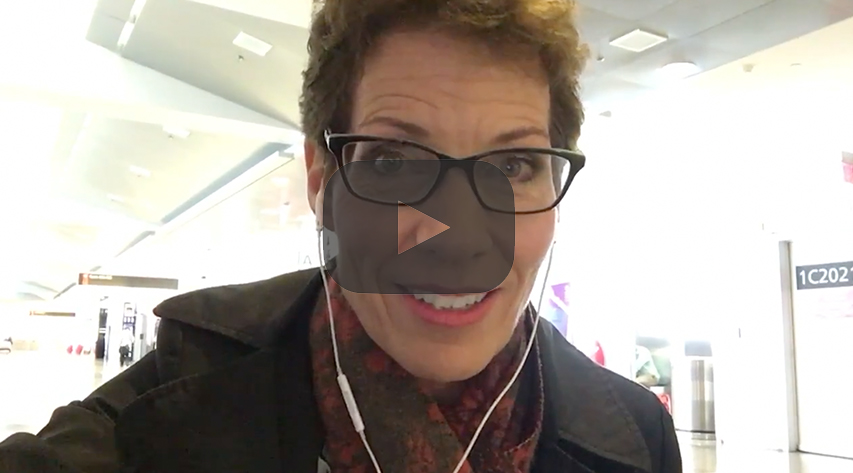If you were driving 80 miles an hour, in the dark, with your lights off, heading towards a cliff, would you like someone to yell, “STOP?”
OK.
Stop!
Do you produce financial reports – the balance sheet and income statement – every week? Do you analyze sales, costs, cash flow, and debt every week? If not, you may be heading for the cliff.
STOP. And find out. This is the year. This is the day. From here on out…you are going to KNOW.
Get to KFP.
KFP stands for Known Financial Position. A KFP is essential to your success and profitability. “Known” is the key element. It may be that you are losing money, or deeper in debt than you would like to be. Find out how much and how deep. That’s the starting place. The financial reports are the Scorecards in the game of business. You can always improve the score. But you must know where you are right now.
This seems obvious. But from my experience as a business consultant, nine out of ten business owners don’t know where they stand financially. There are a couple of reasons for this.
- They don’t know how to keep score.
- They are afraid to look, because they don’t want to know how bad it is.
If you are the one in ten who runs, reviews and understands financial statements, congratulations!
If not, well that’s going to change starting today.
Learning how to keep score
You’ll be at a Known Financial Position when:
- You can generate income statement and balance sheet reports and trust that the information is current and accurate.
- You can go through the reports line by line, account by account, and understand what each dollar amount represents.
I strongly recommend that you do your accounting “in house.” You can’t wait until the month is over to find out the score. You need to know the score while the game is on! You need to run financial reports every week to check sales, expenses and cash flow. You should compile a finished set of financial reports at the end of each month to comply with the tax man, as well as review and revise your financial strategy. The best way to do this is by generating basic financial reports “in house.” Your accountant can support your efforts and check your homework.
Your accountant may be able to train you on how to use your accounting software, or recommend someone who can. You can also contact your accounting software company for a list of qualified trainers. Today’s computers are so fast and accounting software is so simple…you can do the accounting at your shop.
However, you are going to need some help to get to a KFP.
You need a good accountant. Most accountants just prepare tax returns. A good accountant will help you develop an accounting system that delivers the financial information you need to make good decisions. A good accountant will be excited when you tell him that you want to learn how to read and use financial reports. A good accountant won’t feel threatened when you tell him you want to move the accounting system “in house” instead of shipping it out to him.
A good bookkeeper is meticulous about data entry and getting it entered on time. In a small company, you may hold the position of bookkeeper. This will serve you very well in the long run. Embrace the position. Figure out double-entry accounting and how to fully utilize your accounting system. When you are ready to hand off the position, you’ll be prepared to work well with your bookkeeper to receive on-time, accurate and relevant information.
Getting to KFP Exercise
Schedule a meeting with your bookkeeper and your accountant for sometime this week. Go through the balance sheet and income statement, line by line…account by account. Ask these questions:
- What do the account titles mean? (If you don’t know what retained earnings means…ask. If you don’t know what “Other” stands for…ask.)
- Where do the dollar amounts come from?
- What do the dollar amounts represent?
- How does the information get entered into the accounting system?
Review how information moves through the company and ends up on the financial reports. Once, I worked with a company that had adopted a very complex time card. The idea was to get all kinds of helpful information about how each serviceperson at the company spent his day. It was a huge effort, but ultimately every serviceperson was recording sales, lost sales, billable hours, non-billable hours, average sale, add-on sales and travel time. Great data!
Unfortunately, when the bookkeeper entered the data into the accounting system, it was all entered into one account – Payroll expense. So, all that data was collected, and then lost. Find out if that kind of confusion is happening at your company.
Work together to answer these questions:
- How can we structure the Chart of Accounts to better reflect how we do business?
- How can we separate information so that we know how different divisions of the company are performing? Should we create divisions in the accounting system?
- Are we tracking information that we don’t really need?
- What will it take to generate current and accurate balance sheet and income statement reports at any time?
Finally, look over the Month End Checklist together. This checklist makes sure that you stay in a KFP. Ideally, your bookkeeper completes the checklist. Your accountant can help by checking to make sure that your reports are accurate, and that all the legal and tax compliance requirements are handled. Commit to completing the checklist every month, starting right now.
Don’t delay. Insist on meeting this week. Insist on getting to a KFP by the end of this month. It is that important.
“If he appreciates his lack of knowledge he will find a way to acquire it, and it is cheaper to learn before an investment is made in stock and fixtures, tools, etc., than it is to learn afterwards by sad experience.” ~ Wesley A. Fink – Bookkeeping and Cost-Finding for the Plumber, published in 1918.
Good for you for your determination to acquire this knowledge! May 2005 be your best business year EVER!
Month End Accounting ChecklistFor the Month of:___________________ Year:________ Actual Date:_______________________ Prepared By:______________________ |
Complete this checklist on or before the 10th of each month for the previous month.
- Back up of the accounting system files.
- Review the GL for the month and check for anything unusual or out of place.
Accounts Receivable/Invoicing
- Make sure that all sales for the fiscal period have been entered.
- If you job cost, make certain that all sales related to a specific job are coded to that job.
- Make sure that all payments and/or adjustments for the month have been entered.
- Follow up on any receivables that are more than 30 days overdue.
- Make certain that statements have been sent regularly.
Take a look…
- Print an aged Accounts Receivable report.
- The total of all Accounts Receivable should match the Accounts Receivable balance on the Balance Sheet.
Accounts Payable/Purchases
- Make sure that all vendor invoices, payments and adjustments for the fiscal period have been posted.
- If you job cost, make certain that all purchases related to a specific job are coded to that job.
- Post all purchases made by credit cards to their specific liability account.
- Make a “Principal Only” payment to pay down debt
Take a look…
- Print an aged Accounts Payable report.
- The total of all Accounts Payable should match the Accounts Payable balance on the Balance Sheet.
- Print the detail for each credit card used for purchases.
- The outstanding balance of each card should match the corresponding liability account on the Balance Sheet.
Payroll
- Make certain that all paychecks for the period have been entered and posted to the correct expense accounts.
- Make certain that all payroll tax deposits have been made and posted to the correct expense and liability accounts.
- Make sure Acct No 6130 Gross Wages has a ZERO balance.
Take a look…
- Double check that you have posted everything to the correct accounts – this is one of the EASIEST places to make mistakes.
- Review your payroll closely each month to avoid the costly mistake of fixing it later!
Banking
- Bank Accounts—make sure that you have reconciled all bank accounts according to the bank statement. Print the reconciliation report and staple it to the bank statement.
- Petty Cash—make sure that all payments that were made from petty cash have been entered, all deposits to petty cash have been recorded and the account has been reconciled.
Take a look…
- Bank Accounts—compare the reconciled balance to the bank’s balance.
- Petty Cash—make certain that the total you actually have in petty cash matches the Petty Cash account balance on the Balance Sheet.
General Ledger
- Calculate your Billable Hour Efficiency. (See Procedure.)
- Make sure that any journal entries for items such as depreciation have been posted. Once all data entry is complete and all transactions that affect the fiscal period have been posted, you are ready to…
- Create your Month-End closing package.
- Print the following reports:
Balance Sheet
Income Statement with Year-to-Date comparison
Income Statement with budget comparison
Most recent BBB Financial Quick Check report with the supporting financials
- Communicate any discrepancies, challenges, or anything out of the ordinary on the notes section of this checklist.
- Go with your intuition – if you think something looks “weird,” or “off,” or “wrong,” make a note of it and report it to your Manager.
- If changes have been made to the BBB Basic Budget, make sure to update the budget in Quick Books.
- If you have difficulty balancing to any of the above accounts, use your detailed trial balance. Run the report for the account(s)in question for the specific period, and start looking. You might go back to a prior period and compare “then” to “now.”
- Back up and store file off-site!!
Month-end Notes:
Check out the rest of The Bare Bones Biz Plan – Ellen’s Business Building book…written just for YOU!
You know that a sensible diet and exercise plan will get your body toned up and running right. In business, there are a few fundamentals that, if implemented, will result in your success. The Bare Bones Biz Plan is a simple, easy-to-implement plan for crafting your vision and creating your ideal business…using bare bones business basics.
















